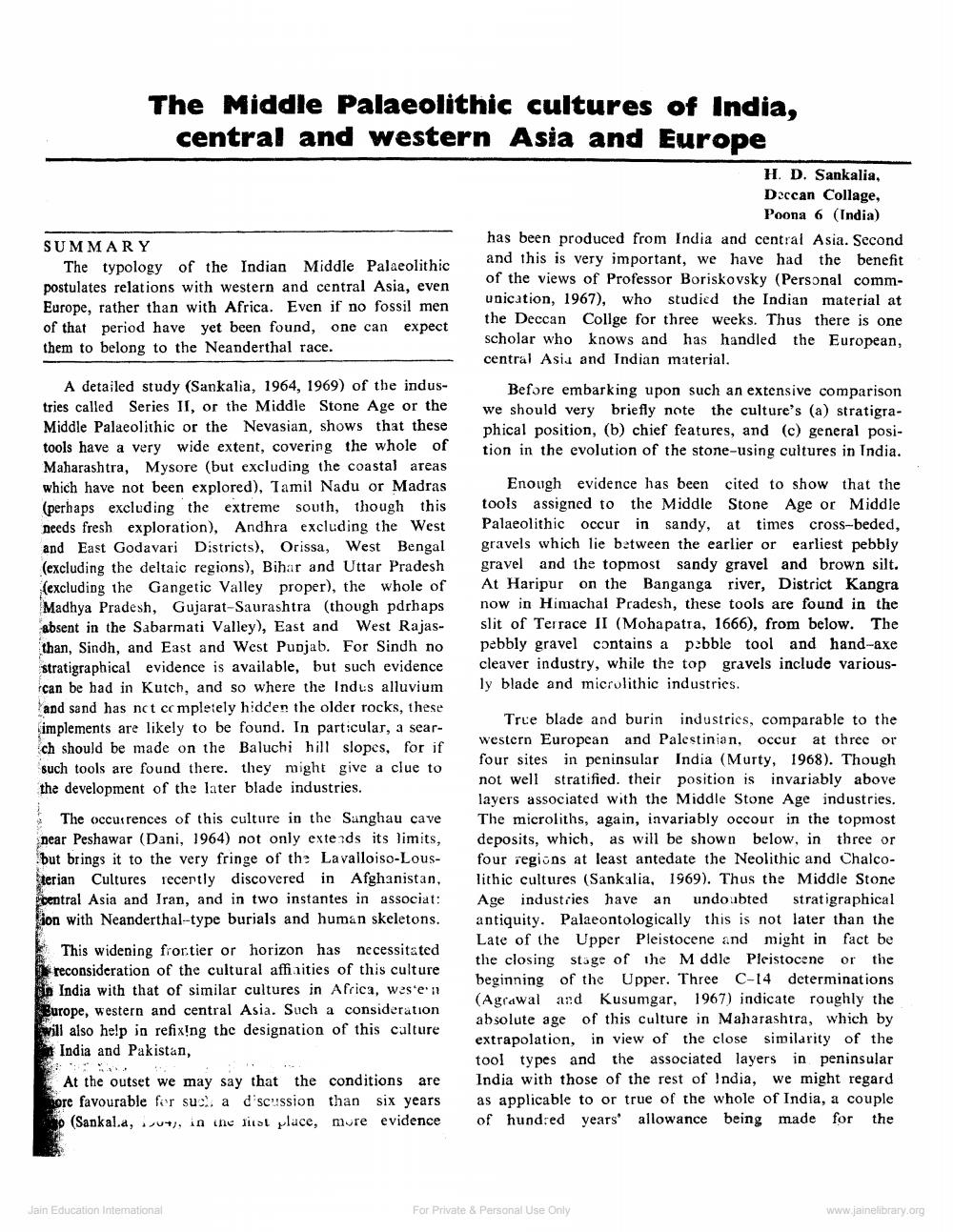________________
The Middle Palaeolithic cultures of India, central and western Asia and Europe
SUMMARY
The typology of the Indian Middle Palaeolithic postulates relations with western and central Asia, even Europe, rather than with Africa. Even if no fossil men of that period have yet been found, one can expect them to belong to the Neanderthal race.
A detailed study (Sankalia, 1964, 1969) of the industries called Series II, or the Middle Stone Age or the Middle Palaeolithic or the Nevasian, shows that these tools have a very wide extent, covering the whole of Maharashtra, Mysore (but excluding the coastal areas which have not been explored), Tamil Nadu or Madras (perhaps excluding the extreme south, though this needs fresh exploration), Andhra excluding the West and East Godavari Districts), Orissa, West Bengal (excluding the deltaic regions), Bihar and Uttar Pradesh (excluding the Gangetic Valley proper), the whole of Madhya Pradesh, Gujarat-Saurashtra (though pdrhaps absent in the Sabarmati Valley), East and West Rajasthan, Sindh, and East and West Punjab. For Sindh no stratigraphical evidence is available, but such evidence can be had in Kutch, and so where the Indus alluvium and sand has not completely hidden the older rocks, these implements are likely to be found. In particular, a search should be made on the Baluchi hill slopes, for if such tools are found there. they might give a clue to the development of the later blade industries.
The occurrences of this culture in the Sanghau cave near Peshawar (Dani, 1964) not only extends its limits, but brings it to the very fringe of the Lavalloiso-Lousterian Cultures recently discovered in Afghanistan, central Asia and Iran, and in two instantes in associat: ion with Neanderthal-type burials and human skeletons.
This widening frontier or horizon has necessitated reconsideration of the cultural affinities of this culture India with that of similar cultures in Africa, weste'n Europe, western and central Asia. Such a consideration will also help in refixing the designation of this culture India and Pakistan,
At the outset we may say that the conditions are hore favourable for suc. a discussion than six years o (Sankal.a, u, in the first place, more evidence
Jain Education International
H. D. Sankalia, Deccan Collage, Poona 6 (India)
has been produced from India and central Asia. Second and this is very important, we have had the benefit of the views of Professor Boriskovsky (Personal communication, 1967), who studied the Indian material at the Deccan Collge for three weeks. Thus there is one scholar who knows and has handled the European, central Asia and Indian material.
Before embarking upon such an extensive comparison we should very briefly note the culture's (a) stratigraphical position, (b) chief features, and (c) general position in the evolution of the stone-using cultures in India.
Enough evidence has been cited to show that the tools assigned to the Middle Stone Age or Middle Palaeolithic occur in sandy, at times cross-beded, gravels which lie between the earlier or earliest pebbly gravel and the topmost sandy gravel and brown silt. At Haripur on the Banganga river, District Kangra now in Himachal Pradesh, these tools are found in the slit of Terrace II (Mohapatra, 1666), from below. The pebbly gravel contains a pebble tool and hand-axe cleaver industry, while the top gravels include variously blade and microlithic industries.
True blade and burin industries, comparable to the western European and Palestinian, occur at three or four sites in peninsular India (Murty, 1968). Though not well stratified. their position is invariably above layers associated with the Middle Stone Age industries. The microliths, again, invariably occour in the topmost deposits, which, as will be shown below, in three or four regions at least antedate the Neolithic and Chalcolithic cultures (Sankalia, 1969). Thus the Middle Stone Age industries have an undoubted stratigraphical antiquity. Palaeontologically this is not later than the Late of the Upper Pleistocene and might in fact be the closing stage of the M ddle Pleistocene or the beginning of the Upper. Three C-14 determinations (Agrawal and Kusumgar, 1967) indicate roughly the absolute age of this culture in Maharashtra, which by extrapolation, in view of the close similarity of the tool types and the associated layers in peninsular India with those of the rest of India, we might regard as applicable to or true of the whole of India, a couple of hundred years allowance being made for the
For Private & Personal Use Only
www.jainelibrary.org




